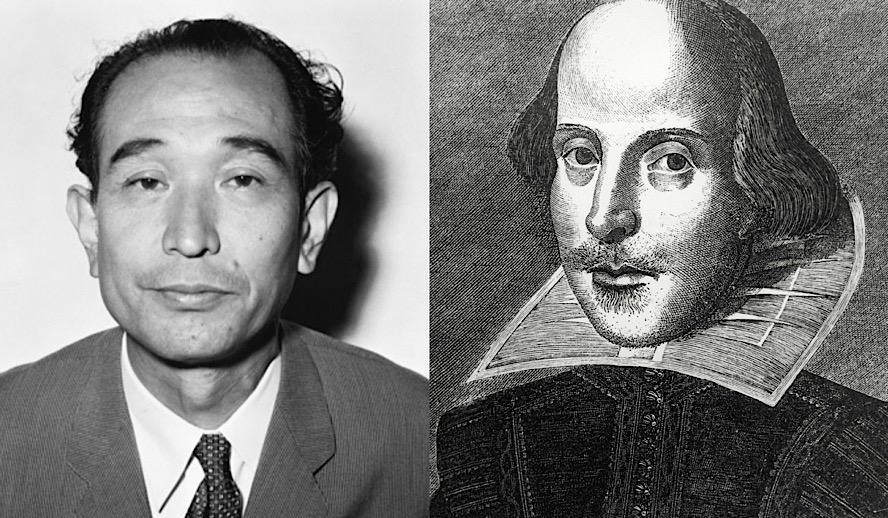Table of Contents

Video Version of this Article
Photo: Kurosawa and Shakespeare
From the likes of Laurence Olivier and Orson Welles to Roman Polanski and Kenneth Branagh, film history is littered with directors who have fancied themselves the definitive cinematic proctors of William Shakespeare’s work. While certain adaptations have risen and fallen over the years, it’s possible that no one auteur has better understood the task of reinterpreting Shakespeare on the silver screen than masterful Japanese filmmaker Akira Kurosawa. The mastermind of foundational classics like ‘Rashōmon’ (1950), ‘Seven Samurai’ (1954), and ‘The Hidden Fortress’ (1958), Kurosawa made a name for himself by grappling with the harsh realities of samurai code.
Related article: Record Breaker: Anime ‘Demon Slayer’ Beats ‘Spirited Away’ as The Biggest Japanese Box-Office Ever
Related article: A Tribute to Satoshi Kon: Genius, Innovator, Filmmaker Transcends Genre Through the Themes of Love and Duality
Related article: ‘House of Gucci’ Full Commentary & Behind the Scenes – Lady Gaga, Adam Driver, Jared Leto, Al Pacino
Kurosawa and Shakespeare
Unlike aforementioned takes on the famed English playwright’s vast body of work, Kurosawa sought to look at the well-worn stories as sandboxes within which he could explore the themes and dynamics that interested him. This led to the production of three films over a three-decade span; an adaptation of Macbeth set amongst the foggy moors of feudal Japan entitled ‘Throne of Blood’ (1957), a corporate crime noir descended from Hamlet termed ‘The Bad Sleep Well’ (1960), and a dazzling samurai epic in the style of King Lear dubbed ‘Ran’ (1985). Each of these not only number among the most acclaimed works of Kurosawa’s distinguished career, but additionally count themselves as some of the most gripping Shakespearean translations in Cinema history.
Limited Time Offer – FREE Subscription to The Hollywood Insider
‘Throne of Blood’ (Macbeth)
With the upcoming release of Joel Coen’s ‘The Tragedy of Macbeth’ (2021), the mythic tale of honor and ambition is about to once again find itself at the forefront of filmic discourse. Shakespeare’s seminal tragedy was first adapted all the way back in 1908, and in the subsequent millennium, the play has seen close to 50 major filmic interpretations. Kurosawa had wanted to take on an adaptation of Macbeth since the earliest days of his filmmaking career, deciding the project to be next-on-deck after completing ‘Rashōmon’.
Related article: EVOLUTION: Every Henry Cavill Role From 2001 to 2021, All Performances Exceptionally Poignant
Related article: EVOLUTION: Every Chris Evans Role From 1997 to 2020, All Performances Exceptionally Poignant
This plan was forced to be put on hold after news broke that the aforementioned Orson Welles would be helming his own rendition set to hit theaters in 1948. Wanting to give the ‘Citizen Kane’ (1941) director the widest berth possible, Kurosawa would not begin working on his Macbeth until nearly an entire decade lay between his project and Welles’. Kurosawa often cited the unlikely societal symmetry between Scotland and Japan during the Middle Ages as the central reason he so ardently wanted to bring the play to life with the fresh perspective of Noh-style drama.
Related article: The Hollywood Insider’s CEO Pritan Ambroase: “The Importance of Venice Film Festival as the Protector of Cinema”
Related article: The Masters of Cinema Archives: The Hollywood Insider Pays Tribute to ‘La Vie En Rose’, Exclusive Interview with Director Olivier Dahan
Related article: – Want GUARANTEED SUCCESS? Remove these ten words from your vocabulary| Transform your life INSTANTLY
In Kurosawa’s ‘Throne of Blood’ the director’s legendary muse Toshiro Mifune slots into the role of the play’s titular tragic hero, here known as Taketori Washizu. Washizu and his fellow samurai general Miki serve under vassal Lord Tsuzuki; overseer of the mystic Spider’s Web Forest. While returning home from a battle, the pair encounter a malignant spirit who informs them that Washizu is destined to overthrow Tsuzuki, and Miki’s son will, in turn, be crowned the new keeper of the Spider’s Web fortress. After informing his wife Asaji portrayed by ‘Tokyo Twilight’ (1957) actress Isuzu Yamada of the prophecy, she manipulates her husband into assassinating Tsuzuki which sets the warrior on a fatal path of death and destruction proving ambition can sometimes be the ugliest of sins.
Related article: #metoo Revolution: Powerful Questions That Need Answers
Related article: FACT-CHECKED Series: Timothee Chalamet and 32 Facts about The Young Superstar
‘The Bad Sleep Well’ (Hamlet)
Kurosawa’s next Shakespearean reimagination would jump forward a handful of centuries, trading the grimy swamps of ancient Japan for the high-rise megapolis that now stretched between its shores. In yet another loose adaptation, Kurosawa took on Hamlet in the guise of the hyper-stylish corporate noir ‘The Bad Sleep Well’. For those narratively unfamiliar with Shakespeare’s Hamlet and the quest of the scorned prince to enact vengeance on those who murdered his father, the story also served as the inspiration for Disney’s ‘The Lion King’ (1994). In Kurosawa’s take on the events, however, the eponymous Hamlet (or Simba for all the Disney fans out there) character, here named Koichi Nishi and again played by Mifune, is a young businessman ascending the corporate ladder of a shady Japanese conglomerate in order to find the men responsible for murdering his father and passing it off as a suicide.
Nishi is forced to descend into darkness as he comes closer to discovering the truth behind his father’s death and begins to untangle the vast web of conspiracies at the heart of the massive corporation. Many find fault in the film’s largely anticlimactic conclusion, but this potentially vexing mundanity is actually an integral formulaic conceit of the revisionist noir movement and ultimately gives ‘The Bad Sleep Well’ a necessary inconclusivity to mirror the unending cycle of corporate misconduct that lies at the film’s core.
Related article: MUST WATCH – The Hollywood Insider’s CEO Pritan Ambroase’s Love Letter to Black Lives Matter – VIDEO
Subscribe to The Hollywood Insider’s YouTube Channel, by clicking here.
‘Ran’ (King Lear)
The last of Kurosawa’s Shakespeare adaptations would come in the form of one of the most viscerally effective and visually mesmerizing films in Cinema history; 1985’s ‘Ran’. One would never be able to guess that Kurosawa was 75 years old when crafting this jaw-dropping epic while watching it, youthful exuberance and playful spontaneity leaking out of every frame. ‘Ran’ serves as a monolithic mash-up of the familial and political intrigue of HBO’s ‘Succession’ (2018-) and otherworldly battle choreography of ‘The Lord of the Rings’ (2001-2003) saga all captured with the mouth-watering floridity of ‘Hero’ (2002).
The film centers around Tatsuya Nakadi’s King Lear-esque elderly Sengoku-period warlord Hidetora Nakadai who elects to divide his kingdom among his three sons rather than seed his throne. His eldest son Taro is to receive the prized “First Castle”, Jiro the “Second”, and Saburo the “Third”. Saburo protests his father’s proposal and is banished from the kingdom, igniting a deadly civil war among the brothers as each vie for power and attempt to ascend to their father’s throne. Each brother is emblemized by their own specific color and as such, the film’s palette is among the richest of all time. The cinematography never misses a beat, transporting audiences from windswept mountaintops to ashes volcanic plains. While routinely hailed as Kurosawa’s final outright masterpiece, it may also be the director’s greatest creation, perfectly embellishing upon Shakespeare’s elemental tale of greed and dishonor and crafting a near-flawless epic in every sense of the word.
By Andrew Valianti
Click here to read The Hollywood Insider’s CEO Pritan Ambroase’s love letter to Black Lives Matter, in which he tackles more than just police reform, press freedom and more – click here.
An excerpt from the love letter: The Hollywood Insider’s CEO/editor-in-chief Pritan Ambroase affirms, “The Hollywood Insider fully supports the much-needed Black Lives Matter movement. We are actively, physically and digitally a part of this global movement. We will continue reporting on this major issue of police brutality and legal murders of Black people to hold the system accountable. We will continue reporting on this major issue with kindness and respect to all Black people, as each and every one of them are seen and heard.
Just a reminder, that the Black Lives Matter movement is about more than just police brutality and extends into banking, housing, education, medical, infrastructure, etc. We have the space and time for all your stories. We believe in peaceful/non-violent protests and I would like to request the rest of media to focus on 95% of the protests that are peaceful and working effectively with positive changes happening daily. Media has a responsibility to better the world and The Hollywood Insider will continue to do so.”
Ways to support Black Lives Matter Movement to end systemic racism
More Interesting Stories From The Hollywood Insider
– Want GUARANTEED SUCCESS? Remove these ten words from your vocabulary| Transform your life INSTANTLY
– Compilation: All James Bond 007 Opening Sequences From 1962 Sean Connery to Daniel Craig
– Do you know the hidden messages in ‘Call Me By Your Name’? Find out behind the scenes facts in the full commentary and In-depth analysis of the cinematic masterpiece
– A Tribute To The Academy Awards: All Best Actor/Actress Speeches From The Beginning Of Oscars 1929-2019 | From Rami Malek, Leonardo DiCaprio To Denzel Washington, Halle Berry & Beyond | From Olivia Colman, Meryl Streep To Bette Davis & Beyond
– In the 32nd Year Of His Career, Keanu Reeves’ Face Continues To Reign After Launching Movies Earning Over $4.3 Billion In Total – “John Wick”, “Toy Story 4”, “Matrix”, And Many More
Kurosawa and shakespeare, Kurosawa and shakespeare, Kurosawa and shakespeare, Kurosawa and shakespeare, Kurosawa and shakespeare, Kurosawa and shakespeare, Kurosawa and shakespeare, Kurosawa and shakespeare, Kurosawa and shakespeare, Kurosawa and shakespeare, Kurosawa and shakespeare, Kurosawa and shakespeare, Kurosawa and shakespeare, Kurosawa and shakespeare, Kurosawa and shakespeare, Kurosawa and shakespeare, Kurosawa and shakespeare, Kurosawa and shakespeare, Kurosawa and shakespeare, Kurosawa and shakespeare, Kurosawa and shakespeare

Andrew Valianti is a writer and an aspiring producer-director, and all-around film lover. While writing both features and reviews for the Hollywood Insider, Andrew has focused on the intersection of cinema and politics as they relate to empowering diverse stories and viewpoints. Through both study and practice, Andrew has seen first hand the many ways in which film and media can have a positive and meaningful impact on everyday lives. His personal views align with the Hollywood Insider, as he views journalism as a means to empower and mobilize positive change rather than spread gossip or negativity. He believes that art ignites action and has sought to pursue stories that further this goal.








